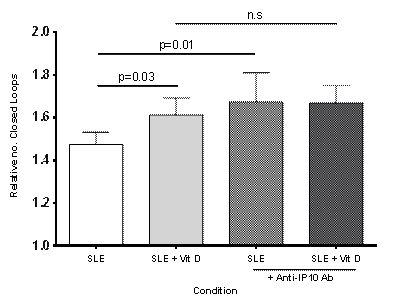Session Information
Session Type: Abstract Submissions (ACR)
Background/Purpose
Endothelial repair is important for the maintenance of vascular integrity and is impaired in patients with SLE. Myeloid angiogenic cells (MACs) contribute to endothelial repair via paracrine secretion of pro-angiogenic factors. These cells express vitamin D receptors (VDR) and so may be modulated by vitamin D status. Given the prevalence of vitamin D deficiency in SLE we aimed to determine whether vitamin D could restore MAC function in lupus.
Methods
SLE patients were screened for vitamin D deficiency (25(OH)D<20ng/ml) using LC-MS and deficient patients were treated with high-dose cholecalciferol for 3 months. Myeloid angiogenic cells (MACs) were cultured from PBMCs of vitamin D deficient lupus patients (or healthy controls, HC) for 7 days. 1,25(OH)2D3 (calcitriol) 10nM or vehicle was added at day 1 and replaced when the media was changed. Myeloid marker expression was measured using RT-qPCR. MAC migration towards SDF-1 was assessed using Transwell assays. Conditioned media from MACs was added to human aortic endothelial cells (HAoECs) on Matrigel for 14 hours and the resulting network analysed. Anti-IP-10 antibody was used to block the effects of IP-10 on network formation. Image analysis of network density (number of closed loops) was performed offline using ImageJ software. IP-10 was measured in the conditioned media by ELISA.
Results
Vitamin D deficient SLE patients had an increased number of MACs compared to controls (p=0.04). Despite this, these cells had impaired migratory capacity (p=0.006) and a trend toward reduced angiogenic capacity (p=0.13). Culture with vitamin D had no effect on lupus MAC migration.
Vitamin D significantly increased the number of MACs in vitro, and in vivo after the patients were treated (p=0.04 and p=0.03 respectively). MACs expressed surface markers consistent with M2 macrophages. The expression CD206 and CD68 was significantly increased in SLE and reversed by vitamin D.
HAoEC network formation was not affected by vitamin D directly but media from vitamin D-treated MACs significantly increased angiogenesis toward that seen in HCs (p=0.01). There was no correlation between MAC number and angiogenesis. IP-10 has previously been reported to be anti-angiogenic and vitamin D significantly reduced IP-10 expression by MACs (p<0.001). Blockade of IP-10 in the angiogenesis model restored the angiogenic capacity of MACs (figure).
Conclusion
MACs are important for endothelial repair and are dysfunctional in SLE. The addition of vitamin D in vitro restores the phenotype of the cells towards that of healthy subjects. Lupus MACs show reduced angiogenic capacity and vitamin D restores this via the down-regulation of the anti-angiogenic cytokine IP-10. Restoration of endothelial repair mechanisms is an important target to reduce vascular damage in SLE and vitamin D is a novel agent to improve MAC function.
Disclosure:
J. A. Reynolds,
None;
D. W. Ray,
None;
Y. Alexander,
None;
I. N. Bruce,
None.
« Back to 2014 ACR/ARHP Annual Meeting
ACR Meeting Abstracts - https://acrabstracts.org/abstract/vitamin-d-restores-lupus-myeloid-angiogenic-cell-function-via-down-regulation-of-ip-10cxcl-10/

